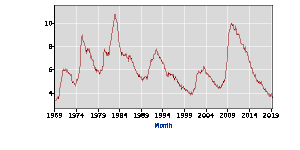Un-unemployed
By Mads Bulkow-Macy | July 19, 2019
The unemployment rate is often used as shorthand for the state of the entire economy. When the Federal Reserve signaled an intent to lower interests rates last week, many news stories supplied context by pointing to recent jobs numbers, headlined by low unemployment. The 3.7% June unemployment rate is near the 50-year low, suggesting that the economy is very healthy indeed. Why, then, would the Fed try to give the economy a boost?
Unemployment is near a 50-year low.

Seasonally adjusted unemployment rate fluctuation since 1969. (Source: Bureau of Labor Statistics)
Jerome Powell’s specific calculus will continue to be the source of much speculation, but one issue that economic headlines could do well to consider is what a low unemployment rate really means. The categories of “employed” and “unemployed”, while at first glance complementary, actually leave out a significant portion of the population. To understand why, it is useful to examine the process by which the Bureau of Labor Statistics develops this statistic.
Since a monthly census of the entire population is infeasible, the statistic is based off of a sample of about 60,000 households, then weighted to be demographically representative for the categories of “age, sex, race, Hispanic ethnicity, and state of residence.” The unemployed/employed determination is made via an interveiw. Reporting employment places a person in the “employed” category. In order to be counted as “unemployed,” a person must:
-
- Not currently have a job.
- Be actively seeking work (in the last four weeks).
- Be available to work, supposing they receive an offer
Anyone who falls into neither the “employed” nor “unemployed” category is (in general) not counted in the workforce.
If we try to look at unemployment numbers and find, for instance, the number of households which are struggling to put food on the table, we will find that it is in many ways inadequate. First, employment in a single job does not necessarily mean that the person in question has sufficient means to support themselves or their family. Thus, it cannot be used as an accurate predictor of the strain on social safety nets. Secondly, there are a large class of would-be workers who do not actively engage in job seeking. These workers may be temporarily unable to engage in such activities, or may have been searching for long enough that they have become discouraged. This group includes those whose skills have become irrelevant in a changing workforce, and are working to learn a new set of skills before they attempt reentry. It also includes those who suspect that their attempts to seek employment will be met with discrimination or hostility. Note that this would disproportionatley affect groups which have probable cause to be concerned about employment discrimination, such as members of the trans community and people of color. Ultimately, the category created is likely to exclude a good portion of those who would consider themselves unemployed, and fails to capture a variety of forms of personal economic distress. It also fails to capture broader economic inefficiencies, such as underemployed workers or workers who have been forced to seek retraining.
In the creation and definition of these categories, the more narrow aim of the BLS seems to be to measure the availability of workers, in comparison to the current workforce. Yet even here it falls short, given the potential for job seekers with irrelevant skills to be counted as available, while underemployed workers – even those actively seeking advancement – are counted as unavailable.
While as a coarse metric the unemployment rate still serves a purpose as an economic indicator, the category of “unemployment” does not represent what it purports to. It would be useful for everyone from journalists to policy makers to treat it with caution, and consider more closely the people and stories it fails to include.
References
https://www.bls.gov/cps/cps_htgm.htm https://www.cnbc.com/2019/07/05/jobs-report-june-2019.html https://www.nytimes.com/2019/07/19/upshot/economy-fed-powell-rate-cuts-analysis.html
